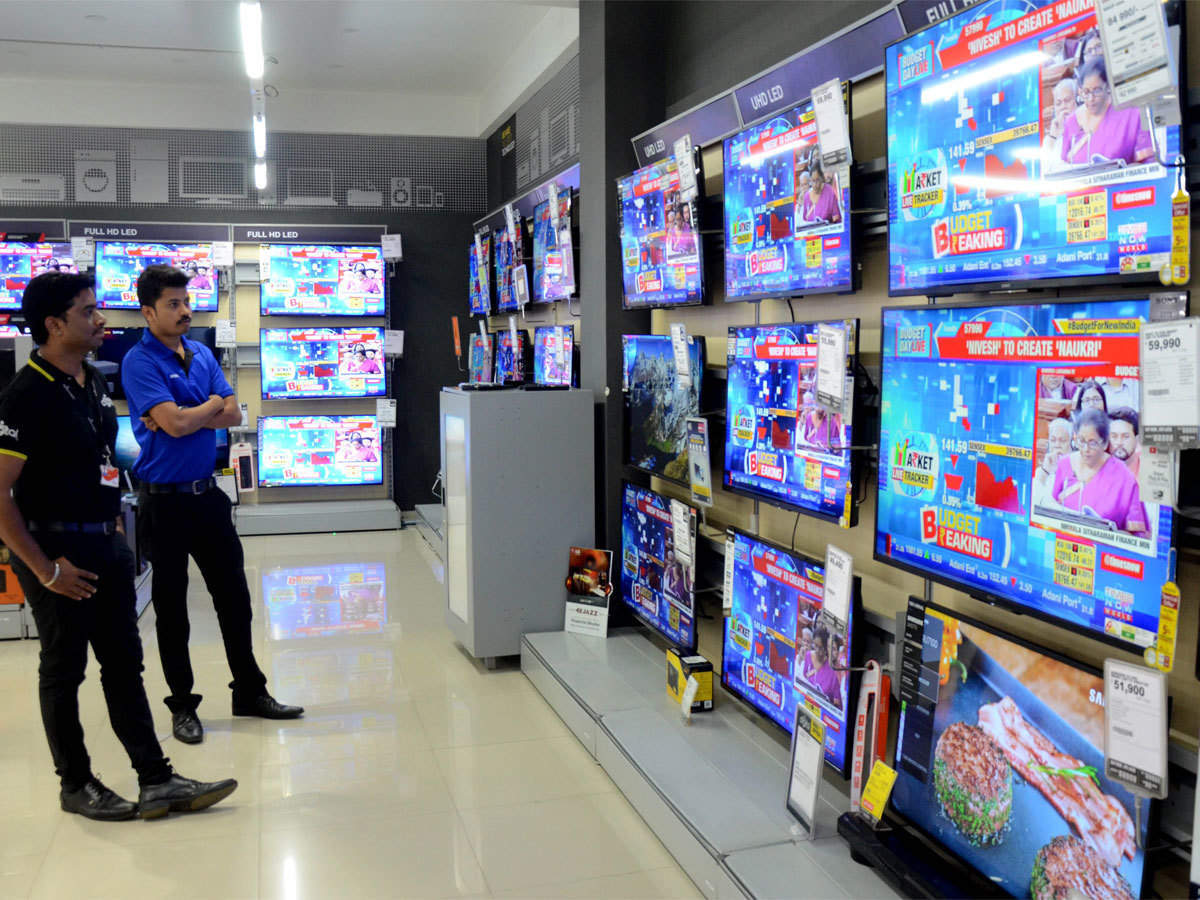The Indian smart TV market, once a growth engine in the consumer electronics sector, witnessed a surprising turn in 2023. While smart TV penetration reached record highs, overall sales figures dipped by 16% compared to the previous year. However, this decline doesn’t paint the entire picture. A closer look reveals a market transformation, with a clear shift towards premiumization and a growing demand for high-quality viewing experiences.
A Market in Flux: Smart TV Sales Decline, But Penetration Soars
A recent report by Counterpoint Research sheds light on the contrasting trends shaping the Indian smart TV landscape. Despite a 16% decline in overall smart TV sales for 2023, smart TV penetration soared to a remarkable 93% – the highest level ever recorded in the country. This seemingly contradictory scenario can be attributed to several factors.

Macroeconomic Challenges: The first half of 2023 was marked by global macroeconomic uncertainties, impacting consumer spending patterns across various sectors, including consumer electronics. Furthermore, excess inventory from previous years also played a role in the overall sales decline.
Shifting Consumer Preferences: Even as overall sales dipped, consumer preferences within the smart TV market began to evolve. A growing interest in larger screen sizes, 4K resolution, and advanced display technologies like QLED fueled demand for premium models. This trend suggests a shift in consumer priorities, with value being placed on a superior viewing experience.
Brand Landscape: Xiaomi Reigns Supreme, But Competition Heats Up
The Indian smart TV market remains a competitive battleground, with established brands vying for dominance. Here’s a breakdown of the current landscape:
Xiaomi Maintains Lead: Xiaomi continues to hold the top spot in the Indian smart TV market, capturing an impressive 11.4% market share in 2023. Their aggressive pricing strategies and focus on value-driven features have propelled their success.
Samsung Hot on the Heels: Following closely behind Xiaomi is the South Korean giant, Samsung. Renowned for its premium offerings and cutting-edge technology, Samsung remains a strong contender in the Indian smart TV market.
LG, OnePlus, and TCL Round Out the Top Five: Rounding out the top five contenders are LG, OnePlus, and TCL. Each brand caters to a specific segment, offering a range of features and price points to attract diverse consumer preferences.
Rise of the Premium Segment: High-Quality Viewing Takes Center Stage
While the overall smart TV market witnessed a dip, the premium segment is poised for significant growth in 2024. This surge can be attributed to several key factors:
Display Panel Price Hike: Rising costs of display panels, a crucial component of smart TVs, are expected to lead to an increase in overall TV prices. This price hike is likely to push budget-conscious consumers seeking a long-term investment toward premium models offering superior technology and value for their money.
Demand for Larger Screens and Higher Resolutions: As consumers become accustomed to enhanced viewing experiences, the demand for larger screen sizes and higher resolutions like 4K is on the rise. Premium smart TVs cater to this growing demand, offering immersive viewing experiences that standard models might not be able to match.
The Rise of OTT Platforms and Content: The burgeoning popularity of Over-the-Top (OTT) platforms like Netflix, Hotstar, and Disney+ is fueling the demand for smart TVs. These platforms offer a vast library of high-quality content, best enjoyed on a smart TV capable of streaming seamlessly.
QLED Emerges as a Budget-Friendly Option for Premium Viewing
One interesting trend within the premium segment is the growing popularity of QLED TVs. QLED technology offers a significant improvement over traditional LED displays, delivering enhanced brightness, color accuracy, and viewing angles. While traditionally associated with high price tags, brands like TCL and Kodak are now offering QLED TVs in smaller screen sizes (around 43 inches) for under Rs 30,000, making this premium technology more accessible to a wider range of consumers.
The Road Ahead: A Market Poised for Transformation
The Indian smart TV market is at a crossroads. While facing a temporary dip in sales figures, it’s undergoing a crucial shift towards premiumization. Consumers are increasingly prioritizing high-quality viewing experiences, fueled by technological advancements, a growing appetite for premium content, and the rising popularity of OTT platforms.
In the coming years, we can expect to see:
Further Growth of the Premium Segment: Premium smart TVs are expected to experience significant growth, driven by the aforementioned factors and a change in consumer buying behavior.
Navigating the New Landscape: Choosing the Right Smart TV in 2024
With the Indian smart TV market evolving rapidly, choosing the right TV for your needs can be a daunting task. Here are some key considerations to guide you:
Understanding Your Needs: Before diving into specifications, take time to understand your viewing habits and budget. Ask yourself: How often do you watch TV? What type of content do you typically consume (sports, movies, etc.)? Do you prioritize screen size or features like voice control? Having clear answers will help you narrow down your choices.
Screen Size and Resolution: Bigger is not always better. Consider your viewing distance – a larger screen might be overwhelming in a smaller room. Similarly, a higher resolution like 4K offers superior picture quality, but ensures your internet connection can handle streaming 4K content without buffering.
Smart Features and Connectivity: Smart TVs boast a variety of features like app stores, voice control, and built-in streaming services. Assess which features are important to you and choose a TV that offers the functionalities you’ll utilize most. Additionally, consider connectivity options like HDMI ports and Wi-Fi compatibility to ensure seamless integration with other devices.
Brand Reputation and Service: Invest in a brand known for quality products and reliable after-sales service. Research online reviews and compare warranty terms before making a purchase.
FAQs:
Q: Is it worth buying a premium smart TV in 2024?
A: If you prioritize a high-quality viewing experience, larger screen size, and advanced features like QLED technology, then a premium smart TV might be a worthwhile investment. However, if you’re on a budget and prioritize basic functionality, a standard smart TV might suffice.
Q: What are some popular OTT platforms in India?
A: Popular OTT platforms in India include Netflix, Hotstar, Disney+, Amazon Prime Video, and Zee5.
Q: What are the benefits of QLED technology?
A: Compared to traditional LED TVs, QLED TVs offer improved brightness, color accuracy, and wider viewing angles, resulting in a more vibrant and immersive viewing experience.
Q: How can I compare smart TVs before making a purchase?
A: Numerous online resources offer detailed specifications and user reviews for various smart TV models. Additionally, visiting brick-and-mortar stores allows you to experience the picture quality and features firsthand before making your final decision.




